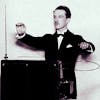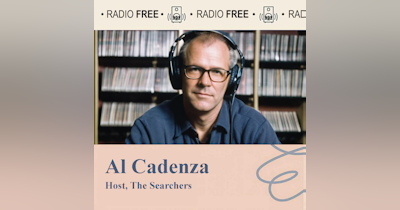If you've watched old black-and-white sci-fi and horror movies, you've probably heard a theremin, even if you didn't know what to call it at the time.
To meet the surging demand for film scores in the 1930s, recently immigrated European classical music composers were quickly wooed and put under contract at major movie studios.
Some were reluctant, concerned their talents would be wasted in Hollywood, and worried about the opinions of their peers. Others saw a golden opportunity for steady, lucrative work and a new creative canvas to experiment on.
As films became more sophisticated, it was crucial to create new soundscapes that evoked emotions in equally new ways.
But the demand for making captivating, groundbreaking film scores goes back to some of cinema’s earliest beginnings… Strategically adopting unique instruments to achieve sounds never heard before.
The theremin is one of the most famous of all. Let’s take a look at how it came to be, its rise and fall within film scores, and its newfound appreciation and resurrection in the 21st Century.
The Curtain Rises
Ever since the first time a pianist sat down and played along to a silent film in 1895, filmmakers have sought to use music to enrapture their audiences.
A mere phonograph or improvised piano accompaniment might work well enough for small theaters… But would be lost in larger venues. By 1910, small ensembles were playing along with the action in larger theaters using well-known classical pieces.
To showcase their product at least somewhat as imagined, studios began providing cue sheets around the same time. These still borrowed heavily from recognizable classical compositions but were at least a sincere effort to match the music to the mood of specific scenes.
Hot on the heels of cue sheets, photoplay music featured all-new compositions for key cinematic moments of a given film… But stopped just short of being a full film score.
While ensembles were busy reaping the rewards of filling the musical void, massive “theater organs” were constructed that allowed a single organist to simulate a small orchestra… Complete with innovations such as percussion, emulations of classical instruments, and even sound effects.
But once synchronized sound became popular and widely available in the late 1920s, films no longer needed to be silent. Theater organists and ensemble players were quickly replaced by full orchestra film scores that played right along with the movie.
And every movie needed a fresh score.
European composers, fleeing persecution, brought their imposing classical chops and creative vision to the United States… And their willingness to experiment with new methods to better complement the films they were scoring.
Electric Euphony
The 1950s were the heyday for the theremin, but it was invented in 1919 by Lev Sergeyevich Termen… Or, as he came to be known in the West, Leon Theremin.
A Russian scientist, Leon Theremin had been working on proximity sensors. He discovered the device gave off a variable, high-pitched hum when his hands were near the antennas. By moving his hands within the magnetic fields generated by the device, he was able to manipulate the volume and pitch.
Theremin drew on his cello training and began playing melodies on his revolutionary contraption in the lab. Theremin quickly recognized that it was not only the first electric musical instrument but one that, incredibly, was played by not touching it.
Realizing he’d created something the world had never seen or heard before, Theremin developed it into a freestanding musical instrument and named it after himself.
Word spread, and in 1922, Leon was called to Moscow to demonstrate it for Vladimir Lenin. Soon, Lenin sent him on successful concert tours around Russia, using the bizarre electronic instrument to promote electrification across the country. Lenin next sent him to Europe and, in 1927, to the United States as a way to show off Russian ingenuity… And spy on the West.
Bolstered by radio broadcasts, the US tour was a huge success. Theremin patented his instrument in 1928 and signed a contract with RCA to mass produce it on the expectation that it would take the United States by storm.
A combination of its high price, difficulty, and The Great Depression derailed those plans.
Back home in Russia, the theremin soon made its cinematic debut in Dmitri Shostakovich’s score for the 1930 film ‘Odna’, but mainly as a sound effect.
While it retained its devotees, it took a few years for the theremin to make a mainstream comeback in the United States. The 1944 musical ‘Lady in the Dark’ marked its first Hollywood appearance. Soon after, Hungarian immigrant and composer Miklós Rózsa famously incorporated a theremin when he was composing the score for Alfred Hitchcock’s 1945 film ‘Spellbound.’
After Rózsa won the Academy Award for his score, other filmmakers and composers took note.
The earliest Hollywood use of theremins capitalized on the warbly eerieness of the instrument as a way of depicting foreboding situations or characters who were unstable. Soon, though, it would be indelibly remembered as the sound of science fiction.
Rockets and Bombs and Aliens, Oh My!
The end of World War II brought about three developments that thrust science into the public consciousness like never before… Nazi Germany’s successful V-2 rockets, the dawn of the Atomic Age starting at the end of the war in 1945, and the “flying saucer” craze that followed only two years later.
Always opportunistic, Hollywood followed the science trend beginning a long tradition of taking enormous liberties with the subject matter.
The first sci-fi movie to use a theremin was 1950’s ‘Rocketship X-M’, a B-movie that tripled the action with rockets, Martians, and atomic devastation all in one go. The theremin was performed by Samuel Hoffman on a score written by Ferde Grofé Sr.
Samuel Hoffman had been an enthusiastic theremin advocate since 1930 and started scoring films himself around this time. His performance on Miklós Rózsa’s aforementioned Academy Award-winning score for “Spellbound” in 1945 made him the go-to thereminist in Hollywood.
Theremins became the iconic sound of 1950’s sci-fi with ‘The Day the Earth Stood Still’, scored by Bernard Herrmann and released in 1951. With their tremulous whine, theremins easily provoked the otherworldly fear, creeping menace, and unknown dangers of the new scientific era.
How fitting that an instrument born of science became the sound of science itself.
While the Cold War had been instrumental in stoking fears of ‘the other,’ the public’s appetite for fictional atomic monsters and flying saucers eventually subsided. But rampant overuse and a glut of cheap, laughably bad movies had already reduced the theremin from terrifying to campy. Later appearances in ‘Scooby-Doo’ signaled a virtual death knell… Gone was the spookiness that had made the theremin so renowned. It had become associated with a dead genre.
But the theremin wasn’t so easily killed.
The Theremin That Wasn’t
Theremins occasionally appeared in popular music and television in the 1960s and 1970s, but seldom made it into noteworthy films… Titles such as 1966’s ‘Billy the Kid Versus Dracula’ were hardly a draw, relegating the theremin to the lowest tier of cinema.
This was, in part, because traditional theremins had largely been supplanted by other electronic instruments that were based on the theremin but not as challenging to play. Though not the same instrument, they kept the familiar sound alive on popular shows such as ‘My Favorite Martian’ from 1963-1966, ‘Dark Shadows’ from 1966-1971, and hit songs such as 1966’s ‘Good Vibrations’ by the Beach Boys.
Around that same time, a young man named Robert Moog was earning his PhD in engineering. Moog had started building and selling his own theremins and theremin kits in 1948 when he was just 14 years old. That experience would inspire him to pioneer his own all-new musical instrument that would invent a whole new music genre… And open the door to the theremin once again.
That instrument was the first fully electronic synthesizer, invented by Moog in 1964.
As popular music widely embraced synthesizers in the 1970s, so too did film score composers... Some, such as John Carpenter, used them for scoring virtually all of his films.
A more balanced view would come from master composer Elmer Bernstein. An early adopter of electronic instruments, Bernstein used a theremin in his score for 1956’s ‘The 10 Commandments’… An unusual choice, maybe, but surprisingly appropriate for a film steeped in the supernatural.
Bernstein’s take was that electronic instruments like synthesizers were just another tool. They were useful for doing things conventional instruments could not, but it was important to use them sparingly and appropriately.
Already an acclaimed composer, Bernstein himself had been in the trenches of Hollywood during the 1950s sci-fi movie craze at the peak of the theremin’s popularity. He had been “grey-listed” and was only able to find work on some of the most notoriously bad films of the era. ‘Robot Monster’ and ‘Cat-Women of the Moon’ weren’t worthy of the scores he wrote.
Bernstein scored with synthesizers at least as early as 1980’s sci-fi drag ‘Saturn 3.’ The novel sounds and applications of this burgeoning tech also set the stage for the revival of the theremin.
In 1981, Bernstein incorporated the sound of a theremin in his score for ‘Heavy Metal’... Except it wasn’t a theremin. It was an ondes Martenot. Devised in France around the same time the theremin was invented in Russia, it was flexible, more versatile, and easier to play.
Bernstein’s use of the ondes Martenot was a regular part of his composing arsenal in the early 1980s. He would again turn to the ondes Martenot when he scored 1984’s ‘Ghostbusters,’ specifically capitalizing on its nostalgic theremin-like qualities to playfully poke fun at the movie’s quirky scientists.
The real turnaround, though, was in the 1990s.
Rising From the Grave
The world was properly re-introduced to the theremin with the release of 1993’s documentary ‘Theremin: An Electronic Odyssey’... Sort of. It was a minor ripple at the time; interesting to its devotees but not many others.
Tim Burton resurrected the retro theremin style for both 1994’s ‘Ed Wood’ and 1996’s ‘Mars Attacks!’, composed by Howard Shore and Danny Elfman, respectively. ‘Ed Wood’ featured an actual theremin performance from Leon Theremin’s last student, Lydia Kavina, a virtuoso on the instrument. ‘Mars Attacks!’ wasn’t so lucky… Lacking a thereminist, they turned to an ondes Martenot to accomplish the effect.
Both movies were humorous love letters to 1950s sci-fi cinema that paid homage to the classic theremin sound while still respecting it.
But the revival was just beginning.
TV, movies, and music have arguably been incorporating more theremin in the last 20 years than the previous 50 combined. And the groundswell has led to new classical works tailor-made for world-class thereminists to take center stage… Just as Leon Theremin had always envisioned.
The Curtain Falls
As for Leon Theremin himself, it's a tragic story. After his theremin failed to take off in the US market, he stayed, married, and worked various engineering gigs until he vanished in 1938… Forcibly taken back to his homeland by Russian agents. He never saw his wife again.
Theremin remained a political prisoner for eight years, but at least his prison was a laboratory for most of it. A “free man” in 1947, he was unable to leave Russia and was made to build espionage devices for the KGB until 1966. He was later employed at the Moscow Conservatory of Music.
With the fall of communism, Theremin finally made it back to the United States in 1991 and was shocked to discover his invention had taken the country by storm after all… If slowly. Leon Theremin died in Russia two years later at the age of 97.
And, while having a theremin in every household never came to pass, you’d still be hard-pressed to find someone today who wouldn’t recognize the sound instantly.
Not a bad legacy after all.
###
photo of Leon Thermin playing his creation. credit unknown.






